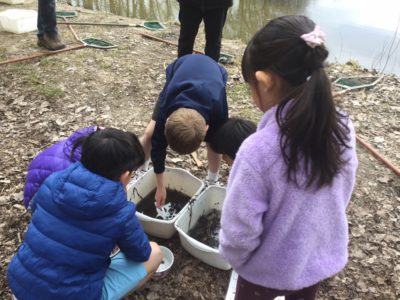By Jo Mathis/AAPS District News Editor
The Thurston Nature Center has received a 2019 Environmental Excellence Award for Water Quality Protection.
“This award was really due to the work of hundreds of volunteers over the last 52 years, since it was a farmer’s field with a wet patch and a wet prairie before that,” explained Jim Vallem, land steward at TNC. “The pond was created around the time the neighborhood was built up, as a retention pond for all the neighborhood runoff. It is now headwaters for Millers Creek, which flows into the Huron River.”

TNC was cited for improvements to the pond and its outlet; the use of four rain gardens in TNC and the school to reduce water pollution; removal of invasives around the pond such as phragmites and purple loosestrife and their replacement with native plants; and other efforts over the years.

Thurston Nature Center is owned primarily by the Ann Arbor Public Schools. The eastern-most portion is owned by the Orchard Hills Athletic Club, with which AAPS cooperates on environmental stewardship projects. The center is used as part of AAPS’ science and environmental education, and the planning committee is a sub-committee of Thurston Elementary’s PTO.
TNC is a member of the Community Partners for Clean Streams, sponsored by the Washtenaw County Water Resources Commissioner’s Office.
TNC is about 20 acres in size, with the 7-acre Thurston Pond.

The preserve is dedicated to educating and providing space to learn about the natural world for those in the school system and the community. The Thurston Nature Center committee originated from a small group of Thurston families, led by Bill Stapp in the 1960s.
According to Vallem, Thurston students have been involved with activities in the nature center from the very beginning about 52 years ago, starting with the very first tree plantings.
See the 1967 video “We’re On our Way” about the early days of Thurston Nature Center: https://www.youtube.com/watch?
Over the years, the committee has led exemplary work in improving the water quality of the Thurston Pond and the downstream Huron River. A few examples of this work include:
- building a prairie and oak savannah which helps soak up stormwater and provides wildlife habitat
- caring for the shoreline by planting and tending to plants that can withstand the variable conditions
- planting four rain gardens throughout the school property and involving students in building, planting, studying and caring for them
- removing excess sediment that had built up in the pond, which improves the water quality downstream
- leading countless nature walks, labeling trees and setting up butterfly surveys – all to encourage people to become more familiar with the natural space in their backyard
- eliminating phragmites and purple loosestrife around the pond and sowing the areas with native plants
- rebuilding the stormwater outlet to include a settling pond which can better capture pollutants before they head downstream.

Be the first to comment